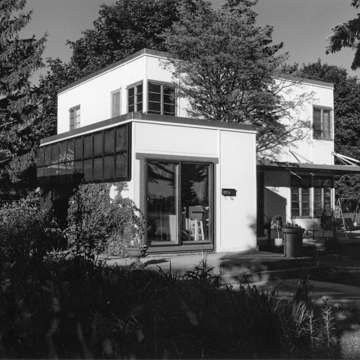The Eggiman House is Wisconsin’s only Motohome, a prefabricated International Style house. Devised by McLaughlin, this design—the first truly prefabricated residence—was an important experiment in industrializing the housing industry in the 1930s. When the Great Depression idled the residential construction industry, McLaughlin sought to solve the resulting housing shortage by designing an inexpensive dwelling that could be mass-produced. American Houses, Inc., with technical assistance from General Electric and American Radiator, developed a prototype of the Motohome in 1932, and it went into full production in 1935. With great fanfare, it was promoted as the affordable house of the future. Sara Delano Roosevelt, mother of President Franklin D. Roosevelt, unveiled the first production model in a ceremony at Wanamakers Department Store in New York City. American Houses marketed as many as 15 variations of the house and boasted that 140 different plans could be built from the modular unit. Assembly simply meant bolting the sections together, a job that could be completed in as little as two weeks, thus minimizing labor expense.
The two-story, cubic Eggiman House was the fifty-fourth Motohome sold, and it may well have been one of the last, since it was built in 1936, the final year of production. The house employs steel-frame construction based on a 4 × 8–foot module, with walls of asbestos concrete panels, manufactured under the trade-name Pyrestos. Aluminum strips cover the vertical joints and draw attention to the panel construction. Casement windows wrap around the corners, and a flat aluminum canopy extends around the corner from the entrance. An attached one-story garage projecting from the southeast corner now serves as additional living space.
Inside, the Motohome came with the latest in domestic equipment. The central air-conditioning, dishwasher, and steel kitchen cabinets were all uncommon for the time. Gadgets and conveniences included a built-in radio and clock, a toaster, a percolator, an iron, a clothes washer, a bathroom scale, an assortment of how-to books, and several days’ groceries. All Ernest and Helen Eggiman had to do was move in and enjoy their “machine built for living.”


